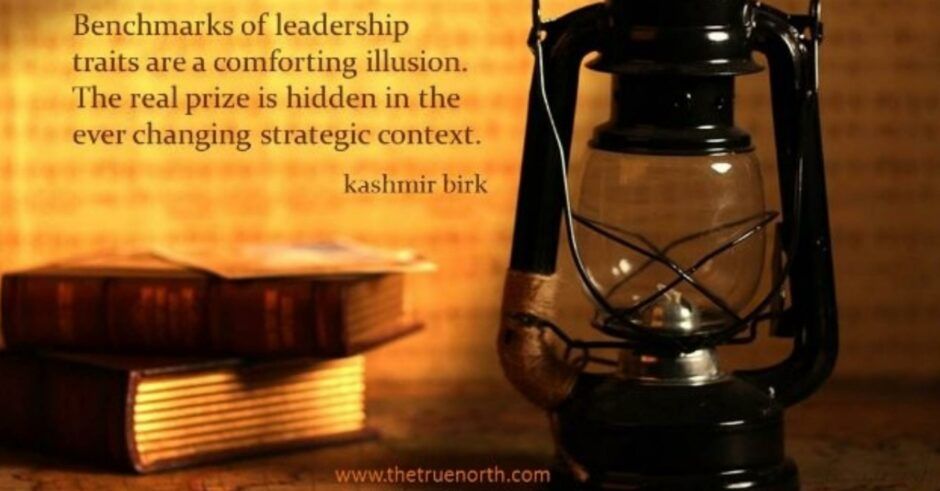Benchmarking of leadership traits are very useful in operational, supervisory level roles where processes are repeatable and reliable.
Model based approaches to assessment and development at the executive level may well be convenient for management consultants, sellers of leadership assessments who need you to buy into their standardized approaches, but at what cost? When the rude awakening of a competitive market shift, regulatory or political change or unanticipated strategic risk surfaces, they will not be accountable for picking up the pieces, you will.
At the executive level the only reality that matters is not leadership models based on other people’s context, but the competitive realities and the shifts in the strategic context at hand.
Senior executives with exceptional leadership traits can be highly successful in one situation or context and yet they can struggle or even flounder completely in a different strategic context.
This is why Michael Jordon a legend in basketball, a great mind, unquestionable leader and supreme athlete looked ordinary in baseball.
When the strategic context changes, past experience can become a liability.
The sophisticated, highly educated leaders and Boards of pioneering organizations such as Imperial Chemical Industries PLC (ICI), Nokia, Compaq, Standard Oil, Saab, Sony Ericsson, General Foods, Wachovia, AOL and Palm were not flawed individuals. To the contrary. These organizations were overflowing with the sharpest minds on the planet.
These iconic organizations vanished, even though their leadership qualities were being benchmarked as global best practices, they had the best people, the (self acclaimed) best consulting firms were working for their Boards, their CEO’s had the best executive coaches money could buy.
What could possibly go wrong?
The quest for certainty is a curious thing. It is the most natural thing. The hunger to know. When leaders move into the executive ranks they take on the work of creating the future, something that does not exist. Diving into the blind ocean depths of uncertainty to surface the unknowable pearls and then make the future happen. This is what their work is all about.
Executive work is not about certainty and more of the same, it is about surfacing the inconceivably obvious and leading the change to make it real.
The more capable the executive leader, the more fundamental and relevant the change. In the meanwhile, leadership models and assessment tools seek to form a perfect circle of certainty.
“The quest for certainty blocks the search for meaning. Uncertainty is the very condition that compels us to unfold our powers.”
~ Erich Fromm
YAHOO!
Marissa Mayer was instrumental at building Google as one of its founding leaders, but despite her undeniable leadership capabilities and traits she was unable to create the turnaround at Yahoo!
Growing a global start-up and turning around a plateaued organization require different traits. Mayer is a world-class leader. No one can deny this. But she did not have the experience to lead in such a fundamentally different context.
Successful as she had been at Google, she needed to change herself to lead in the new context. Doing what made her successful at Google was not enough. She over relied on certainty. As a result she took Yahoo to the same place another pioneering leader ended up. Both Yahoo and AOL vanished in the waiting arms of Verizon.
When the strategic context changes leadership assessments must change or they risk accelerating failure.
NORTEL NETWORKS
Nortel Networks had the best leadership development programs and succession management processes in the world. They were the benchmarked as the best in class for global leadership practices. They were being praised in HBR articles, referenced in leadership books, quoted in conferences and vaulted in consulting pitches around the world.
A consortium of former Nortel CEO’s and retired leaders who had built the business could see only folly.
They saw that Nortel needed to shift from its prowess in fire optics and telecommunications hardware to online software development and consulting. They tried to hire me to advise the Board to make this shift but the Board was not listening.
The Partners from the big consulting firms and assessment industry were telling the Board, John Roth was the man for the job.
John Roth, the CEO of Nortel had built a glowing reputation on the back of a great track record of successful acquisitions. The Nortel Networks Board and their advising consulting firms were all blinded by his early success.
Roth was not taking the shift in competitive context into account. The more Roth and his Board invested in the success of the past, with more acquisitions for a redundant strategy, the deeper they dug a hole for Nortel.
Nortel went bankrupt within five years. They failed because they promoted and supported a leader who could emulate its past but could not see or create its future. They failed because their “strategic” advisors fed them comfort food, and told them what they wanted to hear.
A shift in the strategic context can turn the finest leadership traits and best practices research into poison.
FORD MOTOR COMPANY
While the leaders at the “Big Three” in Detroit, Ford, Chrysler and GM were being benchmarked in leadership programs at Harvard and the top business schools around the world, a humble but fiercely determined engineer, Taiichi Ohno at Toyota was patiently thinking about how to identify slack resources, working tirelessly to remove waste, synchronize operations and surface unseen potential.
When the “Big Three” realized they were no longer going to be the big three, they immediately scrapped their leadership programs to emulate the new global competitive context Toyota and Honda had created.
Donald Peterson, the global CEO of Ford, called his turnaround change program AJ. It stood for “After Japan”. He call it AJ to purposefully press home the wake up call, to abandon myths of the past and a desperate call to humility.
Peterson’s willingness to shift with the context saved Ford. Both GM and Chrysler soon followed and right behind them, the Business Schools, consulting firms and leadership assessment industry followed suit. After the fact.
NETFLIX
Reed Hastings and Marc Randolph made a series of bold decisions. They not only seized the opportunity at the crux of an industry change, but to realize their vision, they challenged and fundamentally changed the way human resource systems worked (or in fact, did not work).
Netflix were intensely customer focused, not only did they wipe Blockbuster off the map, but their down to earth, elegant approaches to HR practices challenged the accepted wisdom of global leaders of HR policies and practices such as General Electric and Unilever. Even the consulting firms such as Deloitte and Accenture who sold consulting in performance appraisal ratings, forced ranking, nine-box grids and competency models, moved away from these archaic HR practices once they saw the fresh new approach being applied at Netflix, Google and Adobe.
At the beginning Reed offered to sell Netflix to Blockbuster for $50 Million. This fateful offer was scoffed with derision by the CEO John Antioco, supported by his Board and their high price management consulting advisors.
After all John Antioco was a highly successful leader up to that point, he had been exceptionally successful at leading the global Blockbuster brand. Who the heck were Netflix? Nothing. But not really. And that’s the point.
CONCLUSION
No leadership assessment process or coaching process was geared to see what Netflix saw at the time. How could they be? Netflix was only just inventing the new business model themselves.
It is not the leadership traits or the strategic context alone, it is the relationship between the two that makes the difference, and that difference could be between an absolute absolute breakthrough and an abject failure.
Leaders allow changing conditions to shape what it means to lead.
No list of executive leadership traits based on a benchmark of best practice is a guarantee of success if it is geared to past performance.
Assessment tools cannot be validated and reliability tested for leadership contexts that do not yet exist, and that is a challenge because the work executives do, is to create the future.
Leadership models are comfort food. They work in the operational domain with front line supervisors and managers where processes are repeatable and reliable. At the executive level these assessment systems are often well-meaning but ultimately a dangerous illusion.
An executive assessment needs to flag a flawed strategic focus otherwise it is executive comfort food at best or at worst contextual poison.
Management consultants, leadership assessment developers, industrial psychologists and executive coaches need to heed Donald Peterson’s wake up call and call to humility.
It is time to stop and resolve the final question (below), before our best intentions accelerate the failure of businesses, stall of careers and ruin the reputations of good people.
Contextual change matters. It rips the heart out of the comfortable illusion of standardized leadership models.
What are the ‘rude awakenings’ in your industry or sector? How are the changing market conditions shaping your leadership assessment and development practices?


